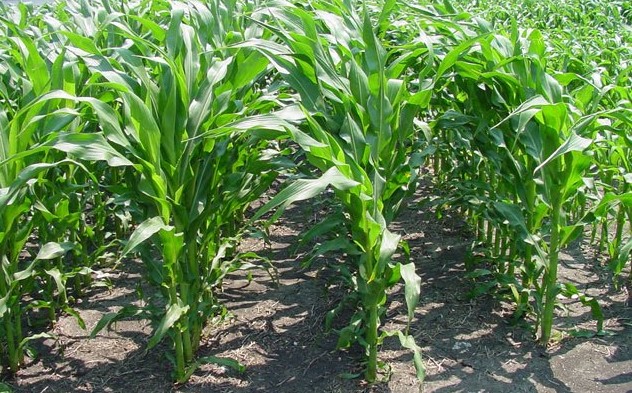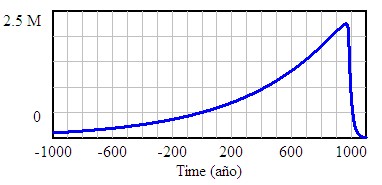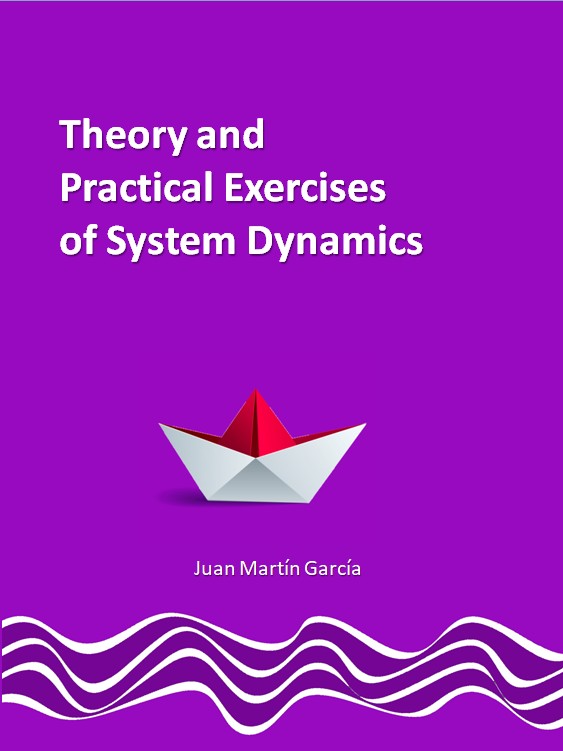4.3. EFFECTS OF THE INTENSIVE FARMING
A simulation model with Vensim
 One of the great mysteries of human history has been the sudden collapse of one of the main centers of Mayan civilization in Central America at a time when it was apparently at a peak of culture, architecture and population around A.D.800.
No one knows exactly why this society of several million people collapsed, but new research shows a gradually tightening squeeze between population and environment that may have been crucial to the fall.
Tropical environments are notoriously fragile. By understanding what the Mayans did to theirs, modern humans may get some useful guidance on how to treat tropical environments today - a realm of knowledge that could be particularly useful to the so called Third World.
Just before the final cataclysm, the new research suggest, the population in one area ranged from about 200 to 500 persons per square kilometer (about four tenths of square mile). This population - density almost certainly required advanced agriculture or large-scale trade.
Within two to four Mayan generations, which probably meant less than 100 years, the population dropped back to what it had been almost 2,000 years before - 20 or less per square kilometer and sometimes far below even that sparse population. Furthermore, after the collapse, whole areas remained almost uninhabited for a thousand years - virtually until the 1970's.
Some of the environmental changes appear to have been as long-lasting as the loss of population. Lakes that were apparently centers of settlement in the Maya time have not even today recovered the state of productivity that made their shores good living places more than 1,000 years ago.
Such clues to the past as these were found, in eight years of research, by scientists at Florida State University and University of Chicago. Their research, still continuing, showed there was an exponential growth in Mayan population during at least 1,700 years in the tropical lowlands of what is now Guatemala.
Human numbers doubled every 408 years, according to the new estimates. This trend may have caught the Maya in a strange trap. Their numbers grew at a steadily increasing pace, but, for many centuries, the growth was too slow for any single generation to see what was happening.
Over the centuries, the increasing pressure on the environment may have become impossible to maintain. Yet the squeeze could have been imperceptible until the final population spurt at the end. In more northerly regions, the quality of Mayan civilization may have deteriorated without so great a population drop, some specialists believe.
The new estimates for the southern lowlands are based largely on a detailed survey of traces of residential structures that were built, occupied and abandoned over the centuries.
The studies are focused on the region of two adjacent lakes, now called Yaxha and Sacnab, in the Peten lake district of northern Guatemala. The area was inhabited as early as 3,000 years ago and the first agricultural settlements appeared there about 1,000 B.C. The land was largely deforested by A.D. 250.
Gradually-intensified agriculture seems to have done severe cumulative damage to an originally verdant environment. To this was added the impact of increases in human dwellings and other major architectural works on the land. Essential nutrients washed, slid and were moved downhill to be lost in the lakes, diminishing the fertility of agricultural land.
Increases in phosphorus in the lakes from agriculture and human wastes showed that pollution must have aggravated the environmental damage. Scientists even confirmed the population trend by estimates of the per capita increase in phosphorus going into the lakes as human numbers rose.
Authors of the research, believe theirs to be the first published report giving documented estimates for the growth pattern of Mayan population and correlating this growth with the damage to the environment that went with it.
The authors pointedly omit any claim that they have solved the long-standing mystery of the Maya collapse.
They do say the kind of environmental pressure their studies suggest may have been one important factor among several. The scientists also believe the research may have some useful practical implications.
"We believe we are doing a kind of archaeology that has a tremendous amount of relevance" said Dr. Don S. Rice, assistant professor of archaeology at the University of Chicago and adjunct assistant curator of archaeology at the university museum.
Dr. Edward S. Deevey, leader of the research team, notes that the Mayan was one of the few high civilizations ever to flourish in lowland tropical forests and that the problems these ancient Central Americans faced may offer lessons for the present and the future.
Dr. Deevely is graduate reseach curator of paleoecology at the Florida State Museum, Gainesville. The other authors, in addition to Prof. Rice are H.H. Vaughan, Mark Brenner and M.S. Flannery of the University of Florida and Prudence M.Rice assistant curator of archaeology and assistant professor at Florida University.
The research to date offers evidence that traditional perceptions of the civilization of the Maya may need to be revised, said Prof. Don Rice.
"Certainly, population was denser that the traditional models suggest" he said. So much population would require advanced agriculture and trade, and evidence is emerging that both existed.
"It adds support to a belief that the Maya were not a peaceful, theocratic, fun-loving, tropical group," he said. Instead, the accumulating evidence suggests, they have become a complex society with advanced agriculture, a managerial elite class and all the stresses, strains and conflicts that go with such size and complexity. Then their way of life collapsed, leaving a severely damaged environment and a cultural vacuum that persisted for many centuries.
One of the great mysteries of human history has been the sudden collapse of one of the main centers of Mayan civilization in Central America at a time when it was apparently at a peak of culture, architecture and population around A.D.800.
No one knows exactly why this society of several million people collapsed, but new research shows a gradually tightening squeeze between population and environment that may have been crucial to the fall.
Tropical environments are notoriously fragile. By understanding what the Mayans did to theirs, modern humans may get some useful guidance on how to treat tropical environments today - a realm of knowledge that could be particularly useful to the so called Third World.
Just before the final cataclysm, the new research suggest, the population in one area ranged from about 200 to 500 persons per square kilometer (about four tenths of square mile). This population - density almost certainly required advanced agriculture or large-scale trade.
Within two to four Mayan generations, which probably meant less than 100 years, the population dropped back to what it had been almost 2,000 years before - 20 or less per square kilometer and sometimes far below even that sparse population. Furthermore, after the collapse, whole areas remained almost uninhabited for a thousand years - virtually until the 1970's.
Some of the environmental changes appear to have been as long-lasting as the loss of population. Lakes that were apparently centers of settlement in the Maya time have not even today recovered the state of productivity that made their shores good living places more than 1,000 years ago.
Such clues to the past as these were found, in eight years of research, by scientists at Florida State University and University of Chicago. Their research, still continuing, showed there was an exponential growth in Mayan population during at least 1,700 years in the tropical lowlands of what is now Guatemala.
Human numbers doubled every 408 years, according to the new estimates. This trend may have caught the Maya in a strange trap. Their numbers grew at a steadily increasing pace, but, for many centuries, the growth was too slow for any single generation to see what was happening.
Over the centuries, the increasing pressure on the environment may have become impossible to maintain. Yet the squeeze could have been imperceptible until the final population spurt at the end. In more northerly regions, the quality of Mayan civilization may have deteriorated without so great a population drop, some specialists believe.
The new estimates for the southern lowlands are based largely on a detailed survey of traces of residential structures that were built, occupied and abandoned over the centuries.
The studies are focused on the region of two adjacent lakes, now called Yaxha and Sacnab, in the Peten lake district of northern Guatemala. The area was inhabited as early as 3,000 years ago and the first agricultural settlements appeared there about 1,000 B.C. The land was largely deforested by A.D. 250.
Gradually-intensified agriculture seems to have done severe cumulative damage to an originally verdant environment. To this was added the impact of increases in human dwellings and other major architectural works on the land. Essential nutrients washed, slid and were moved downhill to be lost in the lakes, diminishing the fertility of agricultural land.
Increases in phosphorus in the lakes from agriculture and human wastes showed that pollution must have aggravated the environmental damage. Scientists even confirmed the population trend by estimates of the per capita increase in phosphorus going into the lakes as human numbers rose.
Authors of the research, believe theirs to be the first published report giving documented estimates for the growth pattern of Mayan population and correlating this growth with the damage to the environment that went with it.
The authors pointedly omit any claim that they have solved the long-standing mystery of the Maya collapse.
They do say the kind of environmental pressure their studies suggest may have been one important factor among several. The scientists also believe the research may have some useful practical implications.
"We believe we are doing a kind of archaeology that has a tremendous amount of relevance" said Dr. Don S. Rice, assistant professor of archaeology at the University of Chicago and adjunct assistant curator of archaeology at the university museum.
Dr. Edward S. Deevey, leader of the research team, notes that the Mayan was one of the few high civilizations ever to flourish in lowland tropical forests and that the problems these ancient Central Americans faced may offer lessons for the present and the future.
Dr. Deevely is graduate reseach curator of paleoecology at the Florida State Museum, Gainesville. The other authors, in addition to Prof. Rice are H.H. Vaughan, Mark Brenner and M.S. Flannery of the University of Florida and Prudence M.Rice assistant curator of archaeology and assistant professor at Florida University.
The research to date offers evidence that traditional perceptions of the civilization of the Maya may need to be revised, said Prof. Don Rice.
"Certainly, population was denser that the traditional models suggest" he said. So much population would require advanced agriculture and trade, and evidence is emerging that both existed.
"It adds support to a belief that the Maya were not a peaceful, theocratic, fun-loving, tropical group," he said. Instead, the accumulating evidence suggests, they have become a complex society with advanced agriculture, a managerial elite class and all the stresses, strains and conflicts that go with such size and complexity. Then their way of life collapsed, leaving a severely damaged environment and a cultural vacuum that persisted for many centuries.

|

 See the book
See the book

 See the book
See the book